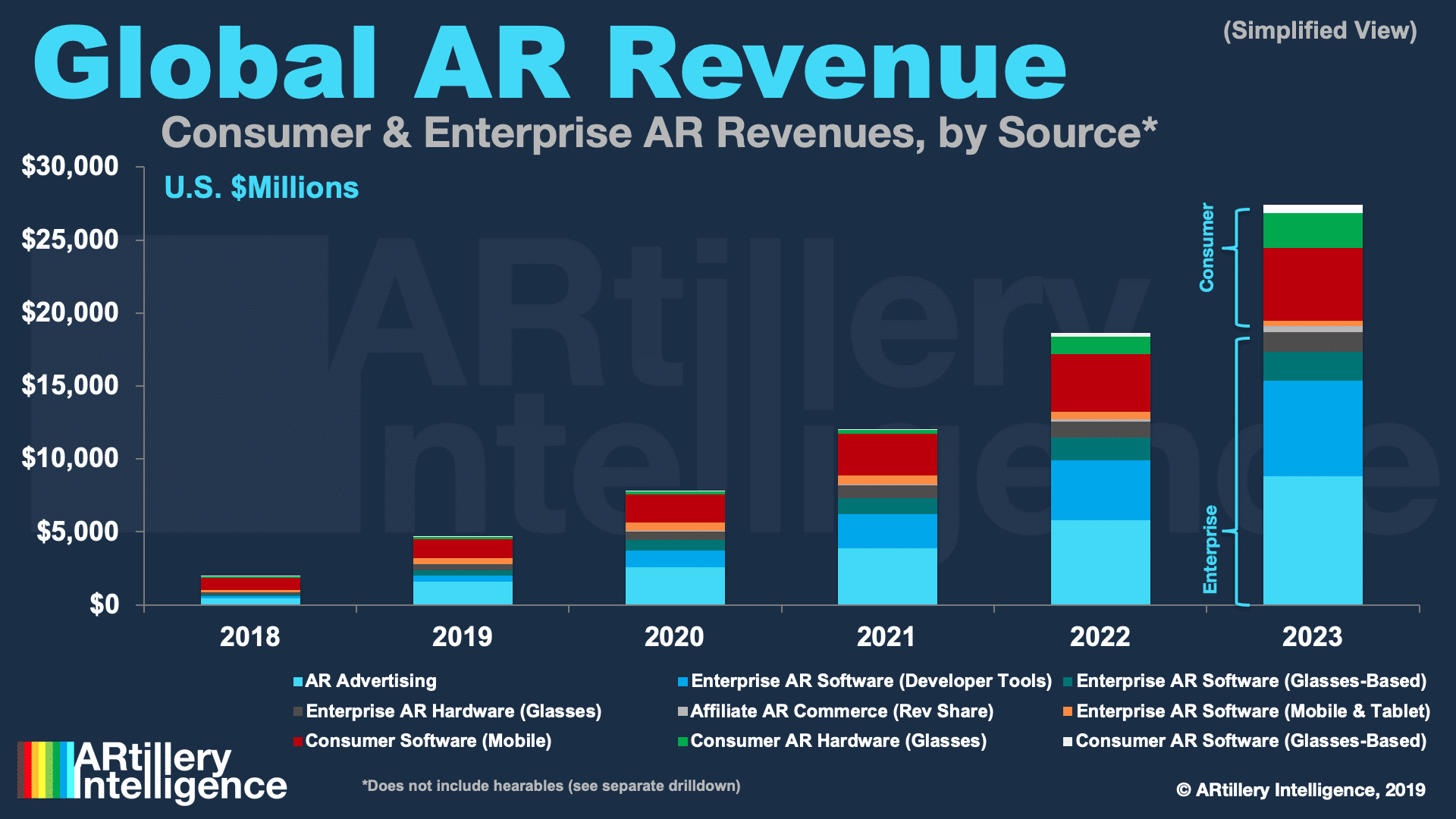
ARtillery Briefs is a video series that outlines the top trends we’re tracking, including takeaways from recent reports and market forecasts. See the most recent episode below, including narrative takeaways and embedded video.
2019 was a “table-setting” year for the spatial future we all envision. There were some flameouts and lessons learned but also some real bright spots. So the question is, where does that leave us as we enter 2020 and how does this illuminate the path forward for spatial computing?
This is the topic of the latest ARtillery Intelligence report, Spatial Computing: 2019 Lessons, 2020 Outlook. Our research arm, ARtillery Intelligence has also boiled down the “2020 Outlook” part into three concrete predictions for the coming year in Episode 34 of ARtillery Briefs (embedded below).

Halo Effect
The first 2020 prediction involves the question on everyone’s mind: Apple AR glasses. Given Apple’s ability to mainstream emerging tech, the AR sector is hoping for some of that signature halo effect to accelerate things. After a disappointing few years, the sector needs a win.
That could come in the form of Apple AR glasses and their mainstreaming effect. But deviating from industry rumors, we don’t believe they’ll arrive in 2020. The underlying tech just isn’t there yet to meet Apple’s industrial design standards. And it’s rarely first to market with emerging tech.
We’ve been saying for a while that 2022 is more realistic for a V1 device. That could feature a “notification layer” or lean-back entertainment, which then evolves over time into sleeker hardware for world-immersive AR. Think of it like the iPhone 1, and subsequent evolution.
The eventual target is a likely an all-day wearable. That could take form in a multi-modal device with variable-opacity lenses for occluded entertainment, and utility-driven AR. Meanwhile, ARtillery projects Apple unit sales of just over 1 million in 2022, followed by almost 3 million in 2023.
Training Wheels
The second prediction is that mobile AR will succeed in 2020 for those who execute “training wheels” strategies. This involves meeting users halfway with AR experiences that tap into existing behaviors or cognition. AR is too early and unproven for them to make the leap on their own.
That’s easier said than done but it can alleviate the adoption barriers that have prevented mainstream consumers from adopting or even understanding AR. A few existing examples are Houzz’ design principle to put AR within users’ path-to-purchase, or Ubiquity 6’s display.land.
Another example we examined recently is Snapchat’s ability to open right to the camera. Notably, training wheels could also tie into Apple’s AR glasses if it starts with an entertainment wearable that eases users into AR through activities they already know… watching TV and movies.
Along the same lines, the rapid growth in wearables adoption could likewise condition users for AR’s future by acclimating people to wearing technology on their bodies. We already see that underway as wearables are exploding as a device class from tech giants across the board.

The Revenue Crown
The third prediction is that advertising will maintain its AR revenue crown. That includes an estimated $1.6 billion in 2019 and $2.58 billion in 2020. This momentum is propelled by existing brand adoption and clear ROI of up to 30 percent boost in conversions for AR-visualized products.
Snapchat is the revenue leader today given its camera-forward focus. But Instagram is a potential sleeping giant for AR lenses, given a strong product-market fit with its camera-forward audience. It’s also in the process of conditioning shopping and transactional use cases where AR will fit well.
Similarly, AR advertising is dominated by front-facing camera lenses today because people like to see their own faces. But rear-facing lenses will gain share with the broader canvas of the physical world. This will bring the AR ad opportunity beyond lenses to utilities like visual search.
In that respect, we’re bullish on Google Lens to gain ad revenue share in beyond 2020. Google is already pushing the technology to future proof it’s core search business. That could hold lots of promise as a high-intent ad vehicle (just like search) and thus high ad performance and premiums.

Pendulum Swing
That just scratches the surface and our full list of predictions includes Enterprise AR and a deep dive on VR. We’ll close in saying that we’re at a point in spatial computing’s lifecycle where the pendulum has swung in one direction towards the exuberance and supply-side saturation,
Then it swung back in the other direction towards market shakeout. We’re now moving slowly towards a middle ground of supply/demand equilibrium. Think of it like the circa 2002 period after the dot-com bubble burst, when things started to move slowly towards measured growth.
That period was followed by the birth of Facebook, Google’s IPO and Web 2.0. With that historical parallel in mind, we could have good things ahead in spatial computing’s lifecycle. The worst is arguably behind us, but what’s fairly certain is that there’s a long road ahead, for better or worse.
See more in the full report or in the latest ARtillery Briefs episode below.
For deeper XR data and intelligence, join ARtillery PRO and subscribe to the free AR Insider Weekly newsletter.
Disclosure: AR Insider has no financial stake in the companies mentioned in this post, nor received payment for its production. Disclosure and ethics policy can be seen here.


